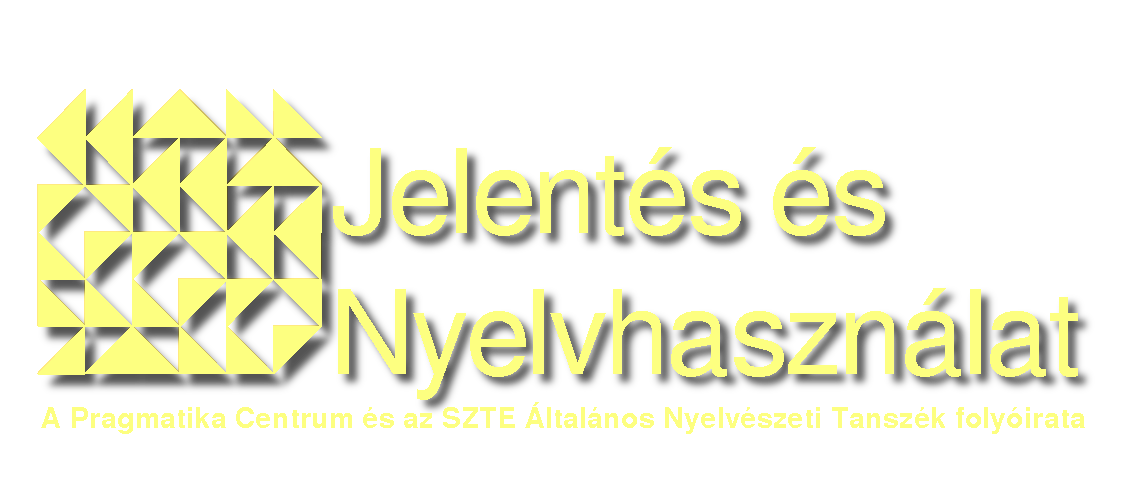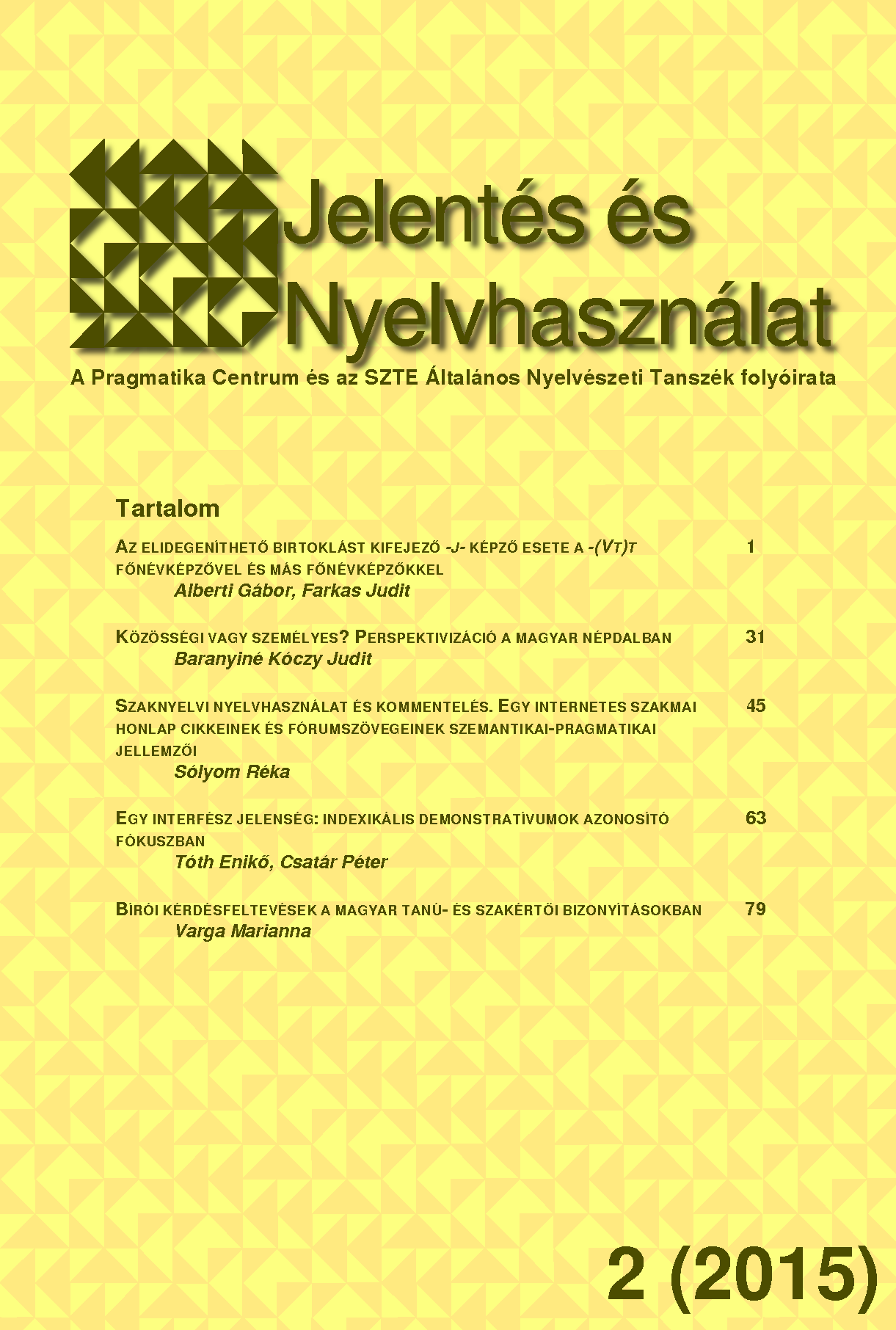Terminological language use and commenting Semantic-Pragmatic features of a professional online website's articles and forum texts
Main Article Content
Abstract
The paper analyses the semantic-pragmatic features of articles and related comments in a professional website called Menedzsment Fórum ('Management Forum', http://mfor.hu) in a functional-cognitive framework. The goal of the analyses is to reveal those organising principles of meaning and understanding that prevail in articles and comments related to different topics of the website. With the help of some arbitrarily chosen examples, the present analysis shows that the occurrence of conceptual metaphors and metonymies, schemas, and conceptual integration, can foster understanding processes up to a great extent. During the analyses, semantic-pragmatic features of single-scope networks, double-scope networks will be studied, and a more complex expression considered as a multiple-scope network (digital Stone Age) will be analysed and represented graphically within the framework of conceptual integration.
Downloads
Article Details

This work is licensed under a Creative Commons Attribution-NonCommercial-NoDerivatives 4.0 International License.
References
Benczes, Réka 2006. Creative Compounding in English. The Semantics of Metaphorical and Metonymical Noun-Noun Combinations. (Human Cognitive Processing 19). Amsterdam: John Benjamins Publishing Company.
Benczes Réka 2014. Ami rímel, az stimmel. Az alliteráció és a rím szerepe a neologizmusokban. In Ladányi Mária – Vladár Zsuzsa – Hrenek Éva (szerk.) Nyelv, társadalom, kultúra: interkulturális és multikulturális perpektívák I–II.: A XXIII. Magyar Alkalmazott Nyelvészeti Kongresszus (ELTE BTK Budapest, 2013. március 26–28.) előadásaiból készült tanulmánykötet. Budapest: MANYE, Tinta Könyvkiadó. 109–114.
Bódi Zoltán 1998. Internetes kommunikáció – beszédkommunikáció. In Gósy Mária (szerk.) Beszédkutatás ’98. Beszéd, spontán beszéd, beszédkommunikáció. Budapest: MTA Nyelvtudományi Intézet. 178–188.
Coulson, Seana – Todd Oakley 2000. Blending basics. Cognitive Linguistics 11/3–4:175–196.
Dér Csilla Ilona 2004. Az internetes fórumok résztvevőinek nyelvhasználatáról. In Bartha Magdolna (szerk.) Nyelv – társadalom – nyelvhasználat. A XIII. MANYE Kongresszus Szociolingvisztika Szekciójának válogatott közleményei. Székesfehérvár: Kodolányi János Főiskola. 33–44.
Domonkosi Ágnes 1999. Tegeződő világháló? Nyelvi udvariasság az interneten. Magyar Tudomány 44/8:1010–1011.
[ÉKSz.2] Pusztai Ferenc (szerk.) 2003. Magyar értelmező kéziszótár. Budapest: Akadémiai Kiadó.
Fauconnier, Gilles 1985. Mental Spaces. Aspects of Meaning Construction in Natural Language. 1994. kiad. Cambridge: Cambridge University Press.
Fauconnier, Gilles – Mark Turner 1998a. Conceptual integration networks. Cognitive Science 22/2:133–187.
Fauconnier, Gilles – Mark Turner 1998b. Principles of conceptual integration. In Jean-Pierre Koenig (szerk.) Discourse and Cognition: Bridging the Gap. Stanford: CSLI Publications. 269–283.
Fauconnier, Gilles – Mark Turner 2003. The Way We Think. Conceptual Blending And The Mind’s Hidden Complexities. New York: Basic Books.
Fauconnier, Gilles – Mark Turner 2009. Mental Spaces and Conceptual Blending. Előadás. Linguistic Structure and Language Ecologies. 2009. július 8. University of California, Berkeley. http://case.edu/artsci/cogs/LSA-8jul09-1.pdf (2014. 2. 3.).
Grice, H. Paul 1975. Logic and conversation. In Peter Cole – Jerry L. Morgan (szerk.) Syntax and Semantics Vol. 3. Speech Acts. New York: Academic Press. 41–58.
Hámori Ágnes 2012. „Tudunk mi normális hangnemben is társalogni”. In Tátrai Szilárd – Tolcsvai Nagy Gábor (szerk.) A stílus szociokulturális tényezői. Kognitív stilisztikai tanulmányok. Budapest: Eötvös Loránd Tudományegyetem. 223–261.
Kövecses Zoltán 2005. A metafora. Gyakorlati bevezetés a kognitív metaforaelméletbe. Budapest: Typotex Kiadó.
Kövecses Zoltán – Benczes Réka 2010. Kognitív nyelvészet. Budapest: Akadémiai Kiadó.
Kövecses, Zoltán – Günter Radden 1998. Metonymy: Developing a cognitive linguistic view. Cognitive Linguistics 9/1:37–77.
Lakoff, George – Mark Johnson 1980. Metaphors We Live By. Chicago, London: University of Chicago Press.
Minya Károly 2011. Változó szókincsünk. A neologizmusok több szempontú vizsgálata. Budapest: Tinta Könyvkiadó.
Nemesi Attila László 2009. Az alakzatok kérdése a pragmatikában. Budapest: Loisir Könyvkiadó.
Panther, Klaus-Uwe – Linda L. Thornburg 2003. On the nature of conceptual metonymy. In Klaus-Uwe Panther – Linda L. Thornburg (szerk.) Metonymy and Pragmatic Inferencing. (Pragmatics & Beyond New Series 113). Amsterdam: John Benjamins Publishing Company. 1–20.
Panther, Klaus-Uwe – Linda L. Thornburg 2006. Metonymy and the way we speak. In Réka Benczes – Szilvia Csábi (szerk.) The Metaphors of Sixty: Papers Presented on the Occasion of the 60th Birthday of Zoltan Kövecses. Budapest: Eötvös Loránd University, School of English and American Studies. 183–195.
Sólyom Réka 2012. Fórumszövegek vizsgálata: neologizmusok elemzése a szemantikai felépítés és a stílus szociokulturális rétegzettségének vonatkozásában. In Tátrai Szilárd – Tolcsvai Nagy Gábor (szerk.) A stílus szociokulturális tényezői. Kognitív stilisztikai tanulmányok. Budapest: Eötvös Loránd Tudományegyetem. 263–299.
Sólyom Réka 2014. A mai magyar neologizmusok szemantikája. (Nyelvtudományi Értekezések 165). Budapest: Akadémiai Kiadó.
Szili Katalin 2004. Szemantika – pragmatika, szemantikai jelentés – pragmatikai jelentés. In Szili Katalin Tetté vált szavak. A beszédaktusok elmélete és gyakorlata. (Segédkönyvek a nyelvészet tanulmányozásához XXXVI). Budapest: Tinta Könyvkiadó. 39–64.
Tátrai Szilárd 2008. Irónia. In Szathmári István (szerk.) Alakzatlexikon. A retorikai és stilisztikai alakzatok kézikönyve. (A magyar nyelv kézikönyvei 15). Budapest: Tinta Könyvkiadó. 311–320.
Temmerman, Rita 2002. Metaphorical models and the translator’s approach to scientific texts. Linguistica Antverpiensia 1:211–226.
Temmerman, Rita 2007. Les métaphores dans les sciences de la vie et le situé socioculturel. Cahiers du Rifal 26:72–83.
Tolcsvai Nagy Gábor 2010. A kognitív szemantika. Nyitra: Konstantin Filozófus Egyetem, Közép-európai Tanulmányok Kara.

